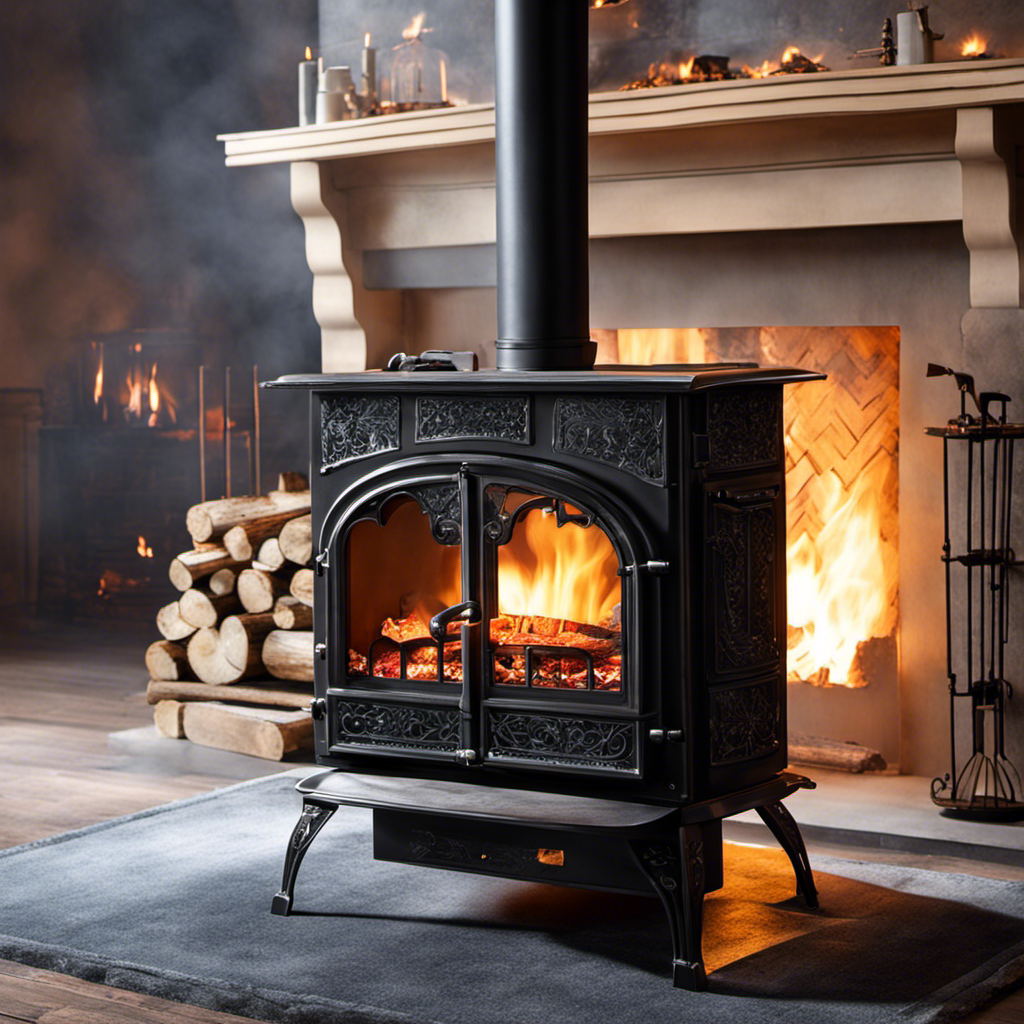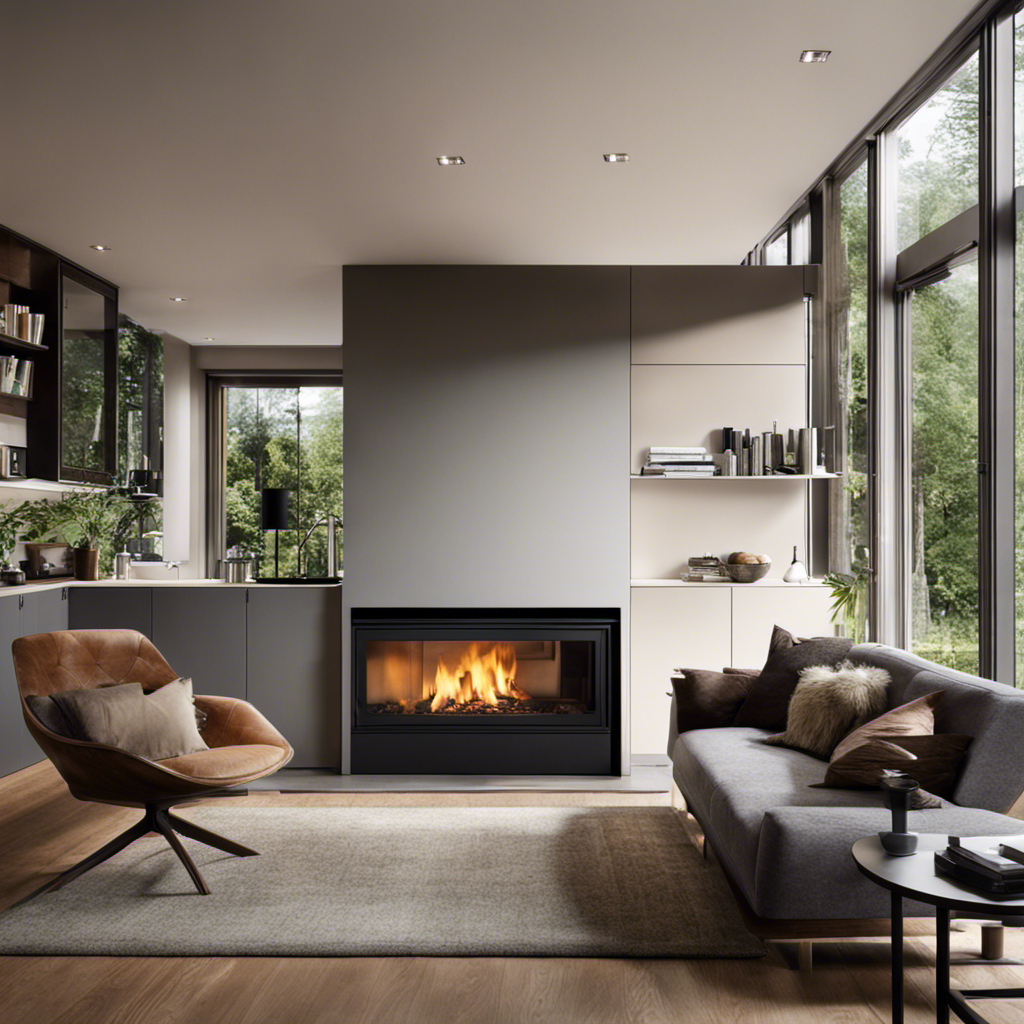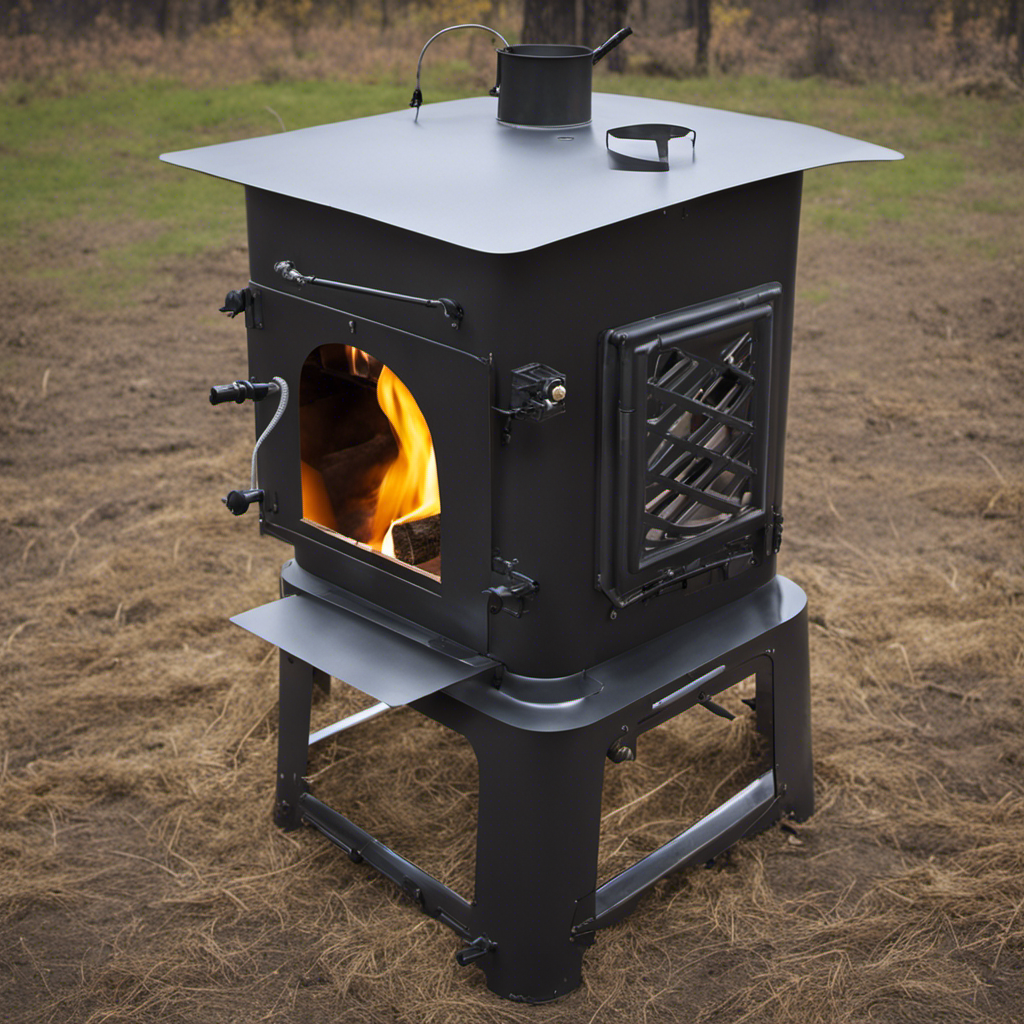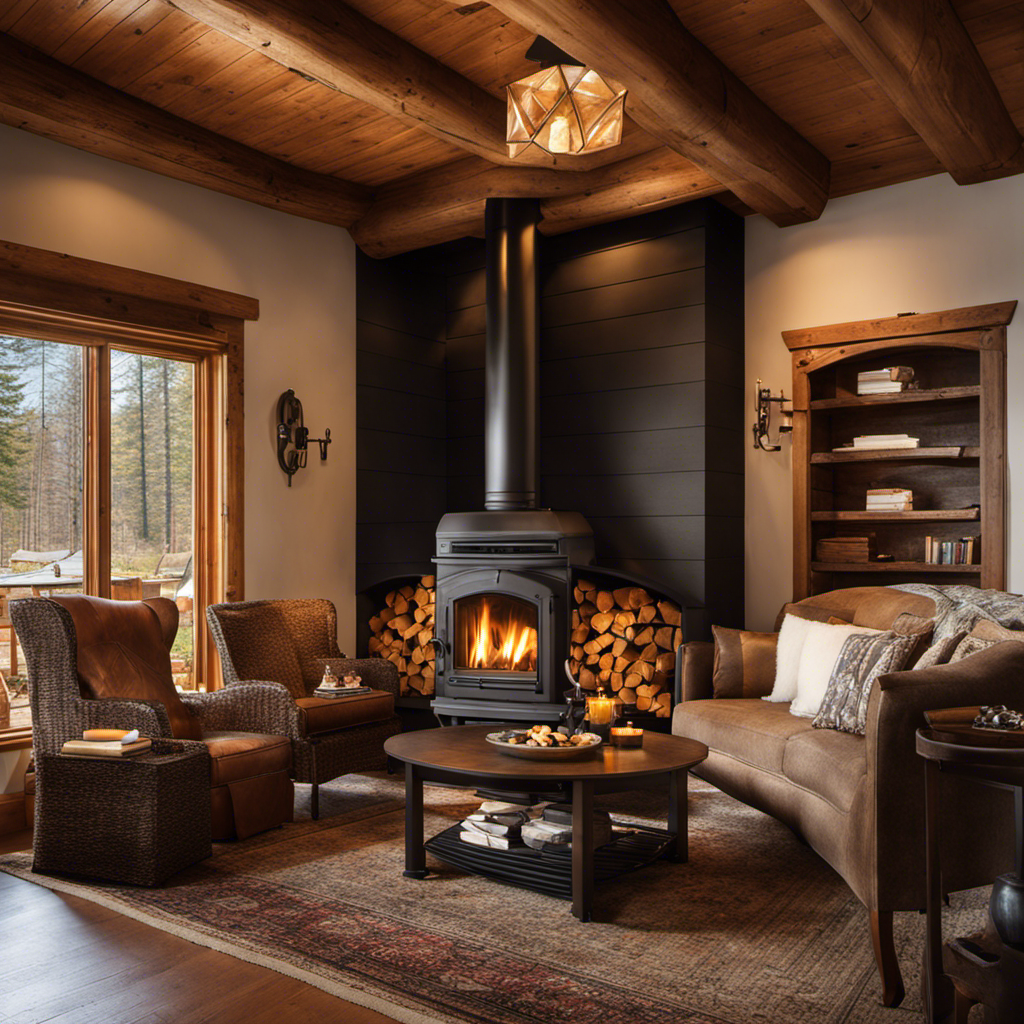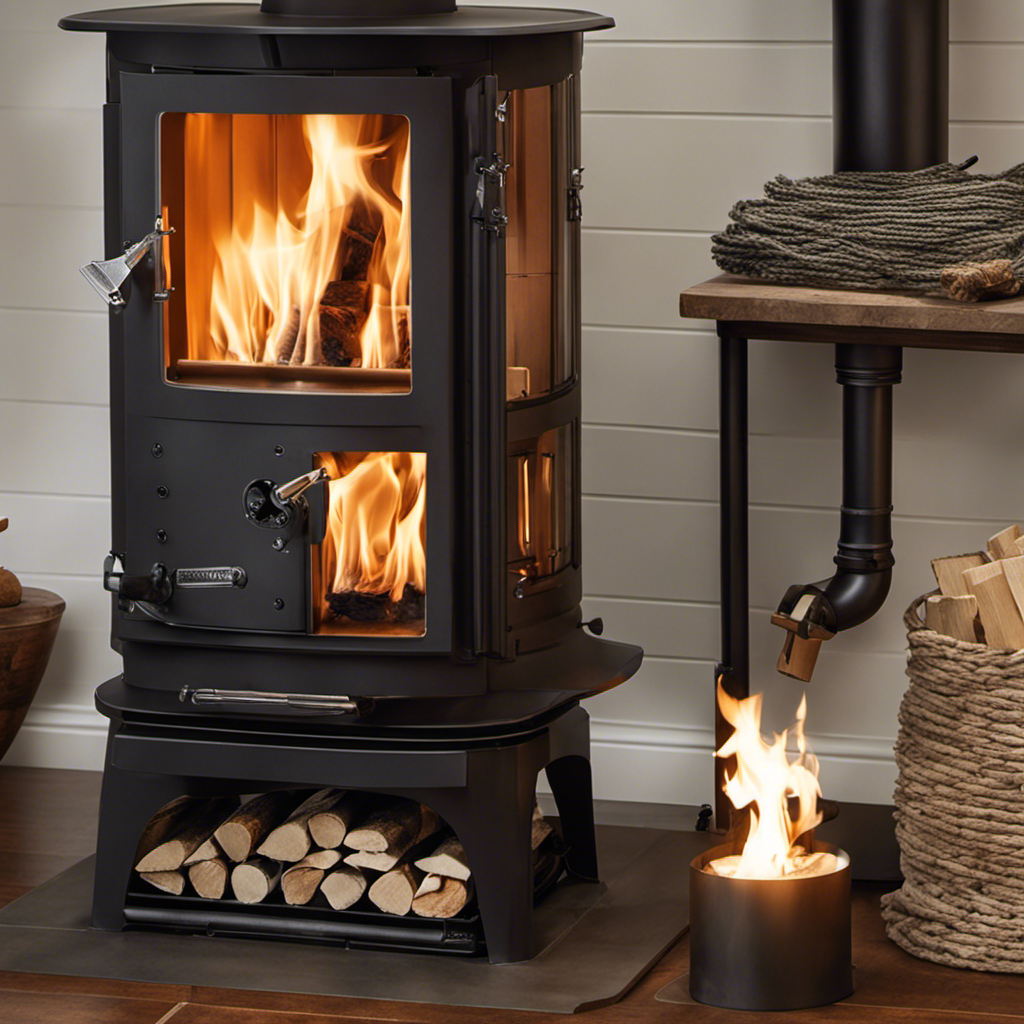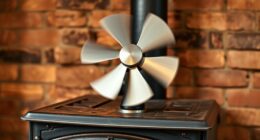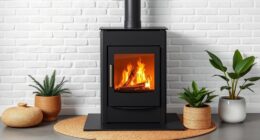I’ve always been intrigued by how a wood stove works. It acts like a small fireplace situated right in your living space, offering warmth and coziness during the chilly winter season.
But have you ever wondered about the science behind it? How does it efficiently burn wood and distribute heat throughout the room?
In this article, we will explore the inner workings of a wood stove, from its components to the combustion process and heat transfer mechanisms. Get ready to delve into the world of wood stoves and unlock their secrets!
Key Takeaways
- The airflow control system is crucial for regulating air intake and heat output in a wood stove.
- Understanding the combustion process, including air intake regulation and secondary combustion, improves fuel efficiency and reduces emissions.
- Heat transfer mechanisms in a wood stove include radiation and convection, which work together to effectively distribute warmth.
- Maintaining and controlling the fire involves adjusting the damper position, primary and secondary air intake, and monitoring fuel moisture content.
The Components of a Wood Stove
I’m learning about the different components that make up a wood stove.
A crucial component of a wood stove is the airflow control system. This system allows the user to regulate the amount of air that enters the stove, influencing the combustion process and heat output. It consists of dampers, air vents, and knobs that can be adjusted to control the airflow. By adjusting these controls, you can increase or decrease the amount of oxygen available for the fire, which affects the fuel efficiency of the stove.
Another important component is the firebox, where the wood is burned. It’s designed to withstand high temperatures and efficiently transfer heat to the surrounding area.
Understanding these components is vital for maximizing the performance and fuel efficiency of a wood stove.
Combustion Process in a Wood Stove
The combustion process in a wood stove is incredibly efficient, producing high levels of heat with minimal waste. This efficiency is achieved through several key factors:
-
Air Intake: Wood stoves are designed with adjustable air vents, allowing for precise control of the combustion process. By regulating the amount of oxygen entering the stove, the efficiency of the burn can be optimized.
-
Insulation: Wood stoves are built with thick layers of insulation, trapping the heat inside the combustion chamber. This insulation prevents heat loss and ensures that the maximum amount of heat is transferred to the living space.
-
Secondary Combustion: Some wood stoves are equipped with a secondary combustion system. This system reintroduces the exhaust gases into the firebox, allowing for a second burn of any remaining combustible materials. This greatly increases the efficiency of the wood stove.
-
Clean Burning: Modern wood stoves are designed to burn wood more cleanly, reducing emissions and the environmental impact of wood stoves. This is achieved through the use of advanced combustion technology and the incorporation of catalytic converters.
Wood stove efficiency is crucial not only for maximizing heat output but also for reducing the environmental impact of wood stoves. With high efficiency, less wood is required to produce the same amount of heat, leading to reduced deforestation and lower emissions.
Now, let’s explore the heat transfer mechanisms in a wood stove.
Heat Transfer Mechanisms in a Wood Stove
I can feel the radiant and convective heat coming from the wood stove, providing warmth and comfort in my living space. The heat transfer mechanisms in a wood stove play a crucial role in distributing warmth effectively.
Radiation heat is the transfer of thermal energy through electromagnetic waves. In a wood stove, the fire emits infrared radiation that directly warms objects and surfaces in its vicinity, including myself. This radiant heat is responsible for the cozy feeling I experience when sitting close to the stove.
Additionally, convection heat plays a part in heating the air in the room. As the hot air rises from the stove, it creates a convection current, circulating the warm air throughout the space. This ensures a more even and widespread distribution of heat, making the entire room comfortably warm.
Understanding these heat transfer mechanisms helps optimize the use of a wood stove for maximum comfort and efficiency.
Maintaining and Controlling the Fire in a Wood Stove
To maintain and control the fire in a wood stove, I can use the damper to regulate the airflow and the amount of oxygen supplied to the flames. This is crucial for achieving optimal combustion and ensuring efficient heat production. Here are four important factors to consider when controlling the draft and selecting the right fuel for your wood stove:
-
Damper Position: Adjusting the damper can control the amount of air entering the stove, affecting the intensity of the fire.
-
Primary Air Intake: This is the main source of oxygen for the fire and should be adjusted to achieve the desired burn rate.
-
Secondary Air Intake: This air supply helps burn any remaining gases and particles, improving efficiency and reducing emissions.
-
Fuel Moisture Content: Using dry wood with a moisture content of around 20% is ideal for efficient combustion and preventing excessive creosote buildup.
Safety Measures for Operating a Wood Stove
To ensure safety while operating a wood stove, it’s important to regularly inspect and clean the chimney. Safety precautions must be taken to prevent potential hazards and ensure the proper functioning of the wood stove.
Firstly, it’s crucial to install a carbon monoxide detector near the wood stove to detect any leaks. Additionally, maintaining proper ventilation is essential to prevent the buildup of harmful gases. Adequate airflow can be achieved by opening a window or installing a dedicated air intake vent.
Regularly cleaning the chimney is necessary to remove any creosote buildup, which can lead to chimney fires. It’s recommended to have the chimney inspected and cleaned at least once a year by a professional chimney sweep.
Frequently Asked Questions
How Do I Properly Season Firewood for Use in a Wood Stove?
To properly season firewood for use in a wood stove, follow these steps: 1) Cut the wood into logs of uniform size. 2) Stack the logs in a well-ventilated area. 3) Allow the wood to dry for at least six months. Common mistakes include using green or wet wood, which can lead to poor combustion and increased creosote buildup.
Can I Use a Wood Stove in a Mobile Home?
Using a wood stove in a mobile home requires proper installation and adherence to safety guidelines. The advantages include cost savings, heating efficiency, and a cozy atmosphere. But remember, safety first!
How Often Should I Clean the Chimney of My Wood Stove?
I clean my wood stove chimney at least once a year to ensure proper airflow and prevent buildup of creosote. Regular chimney maintenance is crucial for safety and efficiency of the wood stove.
What Are the Environmental Impacts of Using a Wood Stove?
Using a wood stove has both environmental benefits and health concerns. The environmental benefits include reducing reliance on fossil fuels and lowering carbon emissions. However, the combustion process can release pollutants that can negatively impact air quality and pose health risks.
Can I Install a Wood Stove Myself, or Do I Need to Hire a Professional?
I can save money by attempting a DIY wood stove installation, but I should consider the advantages of hiring a professional. Their expertise ensures proper installation, reduces the risk of mistakes, and ensures safety.
Conclusion
In conclusion, the wood stove is a remarkable device that effectively harnesses the power of combustion and heat transfer to provide warmth and comfort. By understanding its components, the combustion process, and the mechanisms of heat transfer, one can operate a wood stove efficiently and safely.
Remember to follow the necessary safety measures and control the fire properly. So, next time you cozy up by the fire, appreciate the ingenuity of this timeless anachronism that continues to bring warmth to our homes.
Logan’s affair with adventure began in childhood. He hailed from a small town where vast forests bordered one side and endless shores stretched on the other. His days were spent exploring uncharted woods, climbing tall trees, or listening to the tales of old sailors. This early immersion in a world brimming with stories and mysteries became the foundation of his passion for writing.

